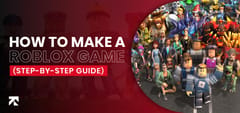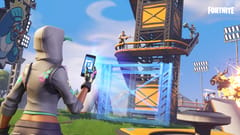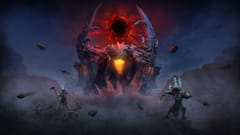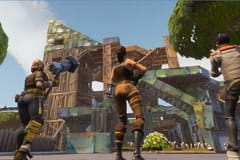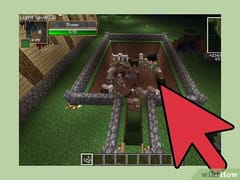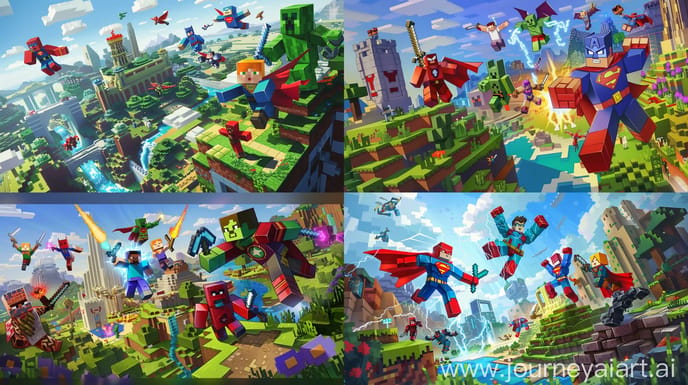
The Artistic Evolution of Minecraft: From Pixels to 3D
Posted by Luke Mitchell October 4th, 2023
In the enchanting realm of Minecraft, where creativity knows no bounds, the game's evolution is not just a story of mechanics and features but a journey of artistic transformation. From its humble beginnings as a pixelated sandbox to the breathtaking 3D masterpieces that grace the virtual landscapes today, Minecraft has become a canvas for artistic expression. In this exploration, we delve into the captivating evolution of Minecraft's artistry, tracing the path from simple pixels to intricate 3D creations that redefine the boundaries of imagination.
The Birth of Pixels: Minecraft's Early Artistic Palette
Minecraft's artistry began with pixels, the building blocks of its visual identity. The iconic pixelated aesthetic, characterized by blocky landscapes and cubic creatures, became the hallmark of Minecraft's early days. The simplicity of pixels not only served as a design choice but also laid the foundation for a style that would become synonymous with the game.
Players embraced the pixelated canvas, creating structures, landscapes, and characters that embraced the charm of low-resolution art. The pixelated world of Minecraft was a testament to the power of minimalism, where each block represented a stroke in the grand tapestry of player-created worlds
Block by Block: Building the Pixelated Landscape
At the heart of Minecraft's artistic expression is the concept of "block by block" creation. The game's building mechanics, centered around placing and removing blocks, gave players the tools to shape their virtual surroundings. From quaint cottages to towering castles, the pixelated landscapes were a testament to the limitless possibilities that emerged from the simple act of stacking blocks.
Block by block, players constructed intricate structures, crafted landscapes that defied gravity, and unleashed their imagination in a world where the only limits were the edges of the screen. The pixelated beauty of these creations resonated with players, creating a visual language that transcended the boundaries of traditional game design.
The Emergence of Texture Packs: Personalizing the Pixel Palette
As Minecraft gained popularity, players sought to personalize their pixelated experiences further. The advent of texture packs allowed users to redefine the visual elements of the game, introducing new textures, colors, and themes. Texture packs became a canvas for artistic expression, transforming the pixelated landscape into realms that ranged from realistic to fantastical.
Players could choose texture packs that turned stone blocks into ancient ruins, transformed the skies into vivid sunsets, or replaced creatures with mythical beings. The emergence of texture packs expanded Minecraft's artistic palette, showcasing the diversity of interpretations that players could bring to the game's visual identity.
Redefining Realism: The Rise of Shaders
As technology advanced, so did the artistic aspirations of Minecraft players. Shaders, a type of mod that introduces advanced lighting and visual effects, emerged as a game-changer in the artistic evolution of Minecraft. Shaders transformed the blocky landscapes into immersive worlds filled with realistic water reflections, dynamic lighting, and atmospheric effects.
The introduction of shaders elevated Minecraft's visual fidelity, turning it into a virtual canvas where light and shadow danced in harmony. From sunsets that bathed landscapes in warm hues to moonlit nights that cast ethereal glows, shaders added a layer of realism that transcended the limitations of the pixelated origins.
Sculpting in Three Dimensions: Minecraft as a 3D Art Platform
While the pixelated aesthetic remains at the core of Minecraft's identity, the game's artistic evolution reached new heights with the introduction of 3D art. The advent of resource packs that incorporated 3D models for items, blocks, and creatures added a new dimension to Minecraft's artistic repertoire.
Players could now sculpt in three dimensions, replacing flat textures with immersive models that added depth and realism. The once-static world of pixels transformed into a dynamic environment where vines swayed in the breeze, leaves rustled, and creatures moved with a lifelike grace.
Player-Created Resource Packs: A Showcase of Artistic Talent
One of the most remarkable aspects of Minecraft's artistic evolution is the role of the community in shaping the visual landscape. The introduction of player-created resource packs allowed artists to contribute their unique vision to the game. From painterly interpretations to hyper-realistic designs, the diversity of artistic styles showcased the boundless creativity within the Minecraft community.
Resource packs became a gallery of artistic talent, with creators showcasing their skills in digital sculpting, texturing, and animation. The collaborative spirit of the Minecraft community turned the game into a living art exhibition, where players could curate their visual experiences by selecting from an array of custom-created resource packs.
Command Block Art: Programming Visual Masterpieces
As Minecraft evolved, so did the means of artistic expression. Command blocks, a powerful scripting tool within the game, opened up new avenues for creating intricate visual masterpieces. With the right commands, players could program moving sculptures, dynamic structures, and interactive installations that pushed the boundaries of Minecraft's artistic capabilities.
Command block art became a form of digital programming, where players embraced the role of virtual engineers, scripting events and animations that unfolded within the game. The fusion of code and creativity turned Minecraft into a dynamic canvas where players could not only build but also script their own artistic narratives.
Adventure Maps and Storytelling: Crafting Visual Narratives
Beyond individual creations, Minecraft became a platform for crafting visual narratives through adventure maps. Players could explore meticulously designed worlds that told stories, unraveling mysteries, and presenting challenges that were not just about survival but also about experiencing a visual journey.
Adventure maps combined the art of storytelling with the visual design, creating immersive experiences that ranged from epic quests to atmospheric horror tales. Minecraft's artistic evolution was no longer confined to static landscapes but extended to dynamic narratives that unfolded as players ventured through custom-crafted adventures.
Minecraft as a Medium: Art Installations and Exhibitions
As Minecraft's artistic evolution continued, it transcended the boundaries of the virtual realm. The game became a medium for art installations and exhibitions that mirrored real-world galleries. Players and artists collaborated to create virtual spaces where sculptures, paintings, and interactive installations became works of art within the game.
Minecraft's potential as an artistic medium reached new heights with events like "Block by Block," where artists recreated real-world locations within the game. The intersection of virtual and real-world art showcased the transformative power of Minecraft as a platform for artistic expression.
The Future of Minecraft Art: A Canvas for Infinite Creativity
As we stand on the precipice of Minecraft's future, the artistic journey is far from over. With each update, mod, and creative endeavor, the game continues to evolve as a canvas for infinite creativity. From pixels to 3D masterpieces, Minecraft's artistic evolution is a testament to the enduring power of a game that empowers players to transform a virtual world into a living, breathing work of art. The pixelated canvas of Minecraft is not just a reflection of the past but a promise of the boundless artistic landscapes that await in the ever-expanding realms of creativity.
